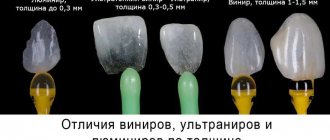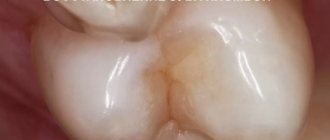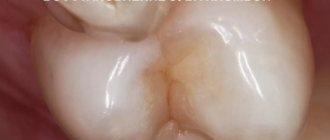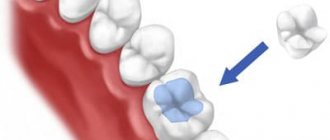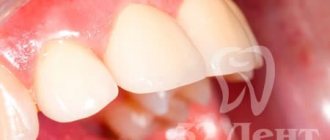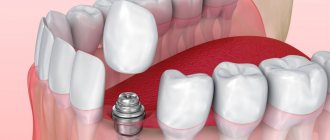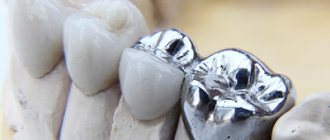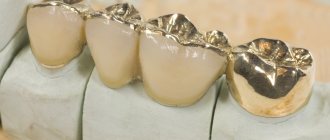Note! ARTE-S Center offers patients high quality ceramics. The clinic has a reasonable pricing policy, so our prices are affordable. Our specialists will eliminate any damage.
A ceramic tooth inlay is better than a conventional filling material, so patients prefer the new design, as it is more technologically advanced and is made using an individual impression.
How does an inlay differ from a filling?
If you compare the functionality and appearance of the insert with native units, there are practically no differences between them. Therefore, microprostheses are actively used for frontal and chewing teeth. It is done personally for each patient. Some believe that the insert is a type of filling. In fact, its parameters are incomparably higher than even modern filling material. This becomes clear if we consider the pros and cons of ceramic inlays. Among the positive qualities it is worth highlighting:
- Increased strength.
- Providing significant strength to unit surfaces.
- High levels of aesthetics. The design is translucent, which accurately imitates a real crown.
- Durability, which is several times longer than the service life of fillings. The inserts retain their original shade for a long time and are resistant to staining.
As for the disadvantages, the system is expensive. This is due to the difficult production of products. True, taking into account all the advantages, the current price is completely justified. It is much lower than that of prostheses. Ceramic inserts are the most successful and aesthetic alternative to both artificial crowns and fillings. They are many times stronger and much more beautiful!
How is ceramic used for inlays?
A technology called CEREC may provide the answer. It is responsible for the high precision of the manufactured structure.
Stages of installing tabs.
- The dentist gets rid of all dental areas damaged by caries and, if necessary, removes the old filling.
- The diseased tooth is scanned using an intraoral device.
- A real model of the tab is created on the computer.
- The ceramic blank is sent for grinding, where, taking into account the created model, the inlay is reproduced with almost 100% accuracy. This is an important step, since high precision allows you to get an inlay that perfectly matches the tooth and enamel.
- Installing the tab and fixing it. Digital technologies have made it possible to forget about crowns and save the tooth from destruction or extraction and develop a design that is distinguished by its strength, durability and compatibility with teeth.
In what cases is it recommended instead of a filling?
When the situation cannot be saved by conventional filling, they resort to fragments of dental units that completely cover the defect. They give organs their original shape and protect them from future destruction. Also, the structure can become a support on which the crown is placed. Ceramic inlays instead of fillings are recommended:
- If the patient has a high degree of sensitivity of the units, due to which the teeth of the opposite side quickly wear out;
- When the patient has mechanical damage to the enamel;
- In case the unit will act as a support for the prosthesis;
- With tooth destruction from a third to 60%;
- If you need to replace large old fillings;
- When a patient has a large cavity formed in a tooth due to caries;
- During root canal treatment;
In fact, the insert is a kind of filling. But inserts are made in the laboratory, and they are used to restore even large-scale damage, when the filling will not hold due to a large void.
Why is precision inlay design necessary?
For small interventions, manual precision work with fillings and additional correction is sufficient.
In large reconstructions, it is often necessary to restore the cusps on the teeth that ensure proper contact. We build an occlusal compass to model the oral cavity so that movements are limited, that is, to ensure the correct mechanics of teeth closure. It is basically impossible to do the same thing in the mouth using filling material. Yes, you can achieve aesthetics with fillings, but correct mechanics with large interventions with several teeth is almost never possible. When a filling is required not on top, but on the side surface of the tooth, it is necessary to restore the contact point (so that the thread passes with a click): this is necessary so that food does not pass down and injure the periodontal papilla. It is very difficult to restore the contact point with the correct anatomy. In addition to the contact point itself, there is an approximal ridge with a triangular fossa. He rolls the food bolus not between the teeth, but towards the chewing surface of the tooth:
On a filling it is often not easy to do this manually. And another difficulty is when we have a defect on the side, and it is critically important that the restoration or filling is level with the level of the tooth: if it is wider, then food will get there and there will be caries below. If already, there will be a step that will create mechanical difficulties.
Types of ceramic inlays
By type, insertion structures are divided into restorative (changing the color and shape of units) and stump structures, which are intended for restoration work on the coronal part. The latest achievement in aesthetic dentistry is the E Max ceramic inlay. It is widely used in European countries. This system is all-ceramic. Its frame consists of zirconium dioxide or glass ceramics. Inserts are divided into groups and according to the composition of materials.
Metal ceramics
Products made from metal ceramics marked a new era in orthodontics. Their tariffs are almost identical to ceramic systems, but the quality is very poor. Such liners may fall out because they are afraid of high temperatures due to the thermal expansion of steel. Therefore, specialists in each individual case determine the material from which the insert will be made.
Pressed ceramics
When an old filling is removed, it is necessary to choose a material that will serve the patient for a long time and will not cause discomfort. In such cases, they often resort to installing pressed ceramic products. The procedure for creating such an insert is very complicated. First, the porcelain is processed through extremely high temperatures and significant pressure. This processing makes it possible to obtain a very durable and strong material – pressed ceramics. With the help of structures made from this material, the most acceptable aesthetic indicators are achieved. However, the strength of such a system is somewhat inferior to similar products made from zirconium.
Zirconium dioxide
If previous products were created from one material or another, then zirconium inserts involve processing ready-made, that is, already created, blanks. Grinding is performed on a pre-made impression of the teeth, or rather, on a modern-made plaster model. Moreover, all this is done in an automatic process under electronic control. The workpiece must be thoroughly fired. Its cavity is filled with a special porcelain substance. Subsequently, the insert, which has already hardened, is attached to the unit that is damaged.
A comparative description of porcelain and zirconium products showed that in terms of external indicators they are practically no different. As for the frame made of zirconium, it has identical strength characteristics to metal structures. Of course, the process of creating an orthodontic device is important. In this case, the entire process is automated, which means that the influence of the human factor is excluded. Of course, this is a huge advantage.
Restoring a tooth with a filling.
When the area of damage to the tooth is small, the filling copes with its task perfectly. The doctor removes the affected areas of enamel and dentin, treats the surface and then begins filling the cavity. Fillings are different, depending on the material used. At Es-Dent Center we use only modern light-curing materials, which are the most aesthetically pleasing, durable and absolutely harmless to the human body. We will talk about the advantages and disadvantages of just such fillings.
| Positive aspects of restoring a tooth with a filling |
|
|
|
|
|
| Disadvantages of fillings |
|
|
|
|
|
|
|
|
|
Yana Dmitrievna Mitskevich
Dentist, therapist
13
years of experience
All types of therapeutic treatment, including endodontic treatment using a microscope, microprosthetics, hygienic procedures of any degree of complexity.
Make an appointment
Establishment technology
High-quality production of modern inserts requires a detailed study of the casts made. The specialist enters all the necessary information into the computer program. It displays pictures and diagrams of the future design. With the help of an electronic program, even minor defects and deviations are eliminated, a shade is selected that is more consistent with the natural healthy units of a particular patient.
Installation of orthodontic ceramic products is possible only on the root organ. Of course, before installing the structure, you need to take into account contraindications. The products are not used for baby teeth, since their service life is short, unlike a ceramic device. Also, the system is placed only on a solid foundation. If the destruction exceeds 60%, the optimal prosthesis option is a crown. After all, in order to fully install the tabs, you definitely need two walls. If caries is present, therapy is first carried out. Treatment of caries in St. Petersburg is carried out in almost every clinic. Choose among them the one that meets modern requirements.
Installation process
Installation is carried out in stages:
- First, a hygienic cleaning procedure and treatment of caries is performed.
- Then the dentist selects the color to match the native shade of natural enamel.
- Then the dental tissues are prepared and an impression of the units is taken.
- Next, the microprosthesis itself is manufactured in laboratory conditions.
- Finally, the structure is installed and fixed with special dental cement.
High-quality dental treatment requires a careful assessment of the finished product so that nothing interferes with biting. The entire procedure involves two visits to the dentist. Contact highly professional specialists who use the best innovations and materials from renowned manufacturers.
What else do you need to know about tabs?
The ceramic products themselves will be found unchanged at the excavations of your home.
Most likely, your remaining teeth will degrade, but the inlays will remain the same. But the material that creates micromechanical connections with the hard tissues of the tooth degrades and accumulates mechanical fatigue. Research is currently underway to improve its qualities. Of importance, composites based on glass ionomer cements have long been widely used. They are very friendly to dentin and release fluoride, which is a cellular poison for bacteria. It is impossible to make a filling entirely from such cements: it will be mechanically unstable and of poor aesthetics. We use this material if there are deep cavities or if we are concerned about possible inflammation of the pulp. We place a layer of this material under the inlay: the overall result is a structure that is good in relation to tooth tissues and is quite stable, capable of withstanding loads. Glass ionomer cement alone cannot withstand loads without an inlay. Inlays protect against hidden tooth defects. If a tooth with a filling cracks, this often means almost the same type of damage as when triplex glass is damaged: the fracture site and many microcracks are visible. Many of them are difficult to track, but in general the material is degrading. If such cracks reach the root, they become a gateway for infection and cause a purulent inflammatory process. This means much more complex consequences, including rapid loss of bone tissue: a defect is formed in the bone tissue, and then there is nothing to put an implant into. We will have to remove the tooth, augment it with xenogeneic bone or mixed with autogenous material.
From scanning to the finished restoration, the patient waits at least 40 minutes - this is design and milling. In complex cases, this is two hours; the median case in the clinic’s practice, taking into account cavity preparation, is about 90 minutes. An inlay for one tooth costs from 44,000 rubles, while a filling for one tooth costs from 9,000 rubles.
PS If you come to our clinics, then say that you are from Habr, there will be a 5% discount.
Possibility of complications and subsequent care
As a result of preparing the desired cavity shape, secondary caries or pulpitis may develop. Those patients who suffer from unit sensitivity are at risk of discomfort. Also, opening the cavity sometimes leads to the insert falling out. Only a doctor can correct the situation. After installing the product, follow the recommendations given by the specialist. It's about careful and regular hygiene. Cleaning takes 2-3 minutes. You should rinse your mouth after every meal. Do not subject your teeth to excessive mechanical stress.
The type of microprostheses considered is the most common today. With it, the dentition always looks aesthetically pleasing, and the patient does not suffer from discomfort, as often happens after filling.
Necessary care for ceramic inlays
Caring for such inlays is in all respects similar to regular oral care. But there is one nuance regarding the issue of hygiene. Since a composite filling is more porous compared to enamel, there is a high probability that over time the material will begin to change color. When performing professional oral care, your dentist should thoroughly clean and polish your fillings. Due to their physical condition, ceramic inlays do not require such care.
Important! It is mandatory to be examined by a doctor once every six months to check the fit of the inlays. When a dark coating forms on the edges of the tab, one can say that microbes appear, which indicate a carious process.
